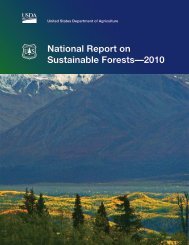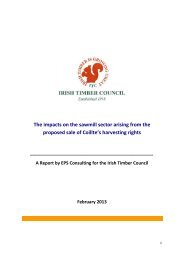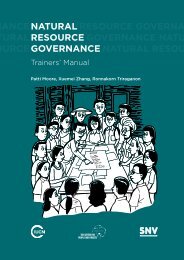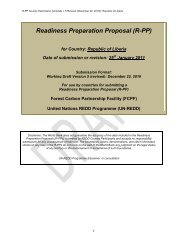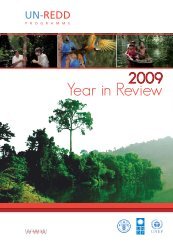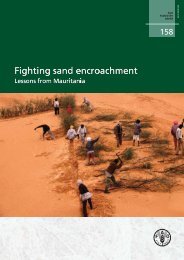pdf 1242 KByte - JIKO
pdf 1242 KByte - JIKO
pdf 1242 KByte - JIKO
You also want an ePaper? Increase the reach of your titles
YUMPU automatically turns print PDFs into web optimized ePapers that Google loves.
Policy Paper: Assessing prerequisites for market-based REDD+ activities 15<br />
the population and do often heavily depend on forest livelihoods (Vatn / Vedele 2011). In such a setting,<br />
secure tenure rights could give local people more leverage in relations with governments and private sector<br />
actors. From an investor’s perspective, financing of REDD+ activities implemented in a country with insecure<br />
and contested forest tenure rights poses several serious threats. Possible tensions with local communities<br />
could bring reputational risks for the investor as well as high delivery risks of REDD+ commitments. Both<br />
types of risks might limit private sector engagement making it difficult to leverage the necessary funding<br />
(Cotula / Mayers 2009). According to Dutschke et al. (2008), both robust tenure systems and a minimum<br />
level of enforcement are necessary for engaging private investors. Broad tenure reforms, which recognize<br />
customary claims and clarify property rights could give fundamental support to the implementation of<br />
REDD+ (Sunderlin et al. 2009).<br />
Intrinsically linked to the issue of forest tenure is the question on the ownership of the carbon stored in the<br />
trees. Since the main idea behind REDD+ is to reduce forestry-related emissions by giving trees an additional<br />
monetary value, carbon will become a new form of asset. With the implementation of REDD+ activities<br />
on the ground, new legal rights are being created: carbon rights. While a single definition is still missing,<br />
the term “carbon rights” can be used to describe the property rights to the carbon stored in biomass as well as<br />
to the right to the benefits arising from the transfers of these rights, for example through emissions trading<br />
(Peskett / Brodnig 2011).<br />
According to Pesket and Brodnig (2011) the relevance of establishing carbon rights varies depending on the<br />
level of implementation and accounting of REDD+ activities in the countries. If REDD+ activities are being<br />
implemented exclusively through policies at the national level, allocation of carbon rights is not necessarily<br />
needed. However, if the government authorises the implementation of carbon projects that are being accounted<br />
for at subnational levels and crediting and trading of carbon rights is allowed subnationally, establishing<br />
of property rights in carbon will be pivotal (Streck 2009). In most countries, the entity that has the<br />
right to the forested land will also have the right to the carbon stored in the forest. Hence, in cases where the<br />
government controls land and forests, carbon rights would stay with the government, while private forest<br />
owners would be authorized to trade the carbon stored in the forests they own. In other countries such as<br />
Bolivia, however, all subsoil resources are owned by the state (Doherty / Schroeder 2011). In such cases, the<br />
legal title to the forest carbon is divorced from the forest tenure ownership and considered a public statecontrolled<br />
commodity. There are several concerns associated with this approach. Effectiveness may be undermined,<br />
since drivers of deforestation and forest degradation would not be targeted directly and REDDincentives<br />
may not reach rural actors (Corbera et al. 2011). Furthermore, if carbon rights can be traded and<br />
sold separately from the land ownership it raises the question whether carbon owners can force landowners<br />
to manage the land in a certain way, particularly threatening poor forest communities (Global Witness 2011).<br />
Therefore, in cases where carbon is treated separately from the question of forests tenure, the protection of<br />
social and environmental safeguards becomes even more central.<br />
Generally, forest tenure and carbon rights can be regarded as two intertwined aspects that are elementary for<br />
most REDD+ activities. Clarification of tenure with due consideration of customary rights would provide a<br />
solid basis for the implementation of several REDD+ activities in developing countries. However, clear carbon<br />
ownership is a necessary precondition only for the implementation of particular REDD+ activities. It<br />
should be noted that formal recognition of these rights is not sufficient but that their enforcement must be<br />
ensured in order to really make a difference.<br />
Nicolas Kreibich, Christof Arens and Wolfgang Sterk<br />
Wuppertal Institute




